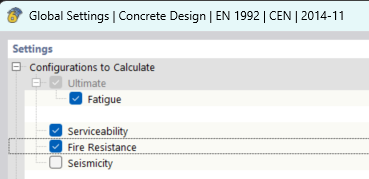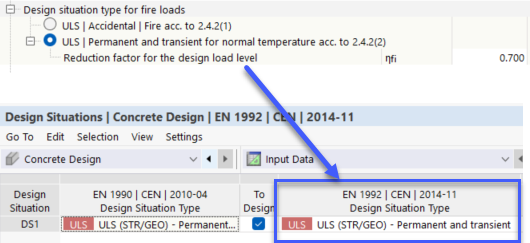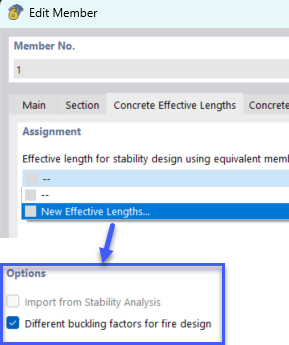Use Fire Resistance Configuration to manage the detailed settings for the fire resistance design of an object.
Currently, the following simplified design methods according to DIN EN 1992‑1‑2 are available:
- Columns according to Section 5.3.2: Method A with the table method according to Table 5.2a, as well as the design with the fire exposure equation 5.7.
- Beams according to Section 5.6: Table method for statically determined and indeterminate beams according to Tables 5.5 and 5.6
- Walls according to Section 5.4: Table method for structural concrete walls according to Table 5.4
- Plates according to Section 5.7: Table method according to Tables 5.8 and 5.9
To activate the fire resistance configurations, as well as the general fire resistance design, you need to select the corresponding options in the Global Settings dialog box of the Concrete Design add-on.
Fire Exposure and Flaming Direction
You can define here the fire exposure to be designed. The time entries from R30 to R240 are set by default, and you can select them in the drop-down menu, but also enter the time manually.
The designed flaming direction refers to the local axis coordinates of the cross-section.
Design Situation Type
There are two alternative ways to select the loads for the fire resistance design.
For the "ULS | Accidental | Fire acc. to 2.4.2(1)" option, the loading is selected directly from the design situation type on the load side. For the design situation type on the design side, it is necessary to select "ULS (STR/GEO) – Accidental – Fire", otherwise no calculation is carried out. We recommend a design situation type on the load side that takes into account the accidental load combinations for fire.
For the "ULS | Permanent and transient for normal temperature according to 2.4.2 (2)" option, the loads from the design situation type on the load side are reduced by the ηfi factor. For the design situation type on the design side, it is necessary to select "ULS (STR/GEO) – Permanent and transient", otherwise no calculation will be carried out. The design situation type of cold-state design on the load side is recommended here.
Column Design
In order to recognize a column, it is necessary to assign an effective length when editing the member. Here, you can distinguish the effective length of the design at normal temperature, and a separate effective length for the fire resistance design. As of a fire exposure greater than or equal to 30 min, the fire buckling length between 0.5 * l and 0.7 * l may be assumed according to Section 5.3.2 (2).
Design According to Table 5.2a
The simplified table method according to Table 5.2a only applies if the following boundary conditions are met:
- The buckling length for the fire resistance design must be less than or equal to 3.0 m.
- The load eccentricity according to the linear static analysis must be observed: e = M0Ed,fi / NEd,fi ≤ emax
- The longitudinal reinforcement of the column in the section must be less than 4% of the concrete cross-sectional area.
Design According to Fire Exposure Equation 5.7
The equation for the fire exposure only applies if the following boundary conditions are met:
- At least four rebars (corner bars) must be placed in the column.
- The axis distance of the longitudinal reinforcement must be at least 25 mm.
- The fire buckling length must not exceed 6.0 m.
- Only rectangular cross-sections with the limit b' ≥ 20 cm are valid, where b' = 2 * Ac / (b+h) is calculated with the limit value of h = 1.5 * b; however, circular cross-sections with a diameter of at least 20 cm are also possible.
Beam Design According to Tables 5.5 and 5.6
The following beam cross-sections acc. to Figure 5.4 are currently available for the calculation:
- a) Constant width = Massive Rectangle (R_M1) and Massive Square (SQ_M1)
- c) I-Section = Massive T-Section (T_M1) and Massive Doubly Symmetric I-Section (ID_M1)
All members are designed automatically according to Table 5.5 for statically determined beams without further settings.
If you want a continuous beam to be recognized and designed by the program according to Table 5.6, you should pay attention to the following:
- In order to recognize the continuous beam as a beam, it is necessary to define the intermediate supports in the "Design Supports and Deflection" design property.
- In the "Design Support and Deflection" option, you can define the moment redistribution for the inner supports. This may not be more than 15%, otherwise the beam is designed as statically determined.
- For fire exposures as of R90 to R240, the required increment or reinforcement design applies according to Equation 5.11. If the required reinforcement in this equation is not available, the member is designed as statically determined.
Average Axis Distance According to Equation (5.5)
If this option is deactivated, the distance from the cross-section edge to the center of the nearest longitudinal reinforcement steel is selected for the axis distance. This is the default setting for single-layer reinforcement.
If you activate this option for multilayer reinforcement, an average axis distance is calculated. Thus, the applicable axis distance increases and has a positive effect on the cross-section requirements in the table.







